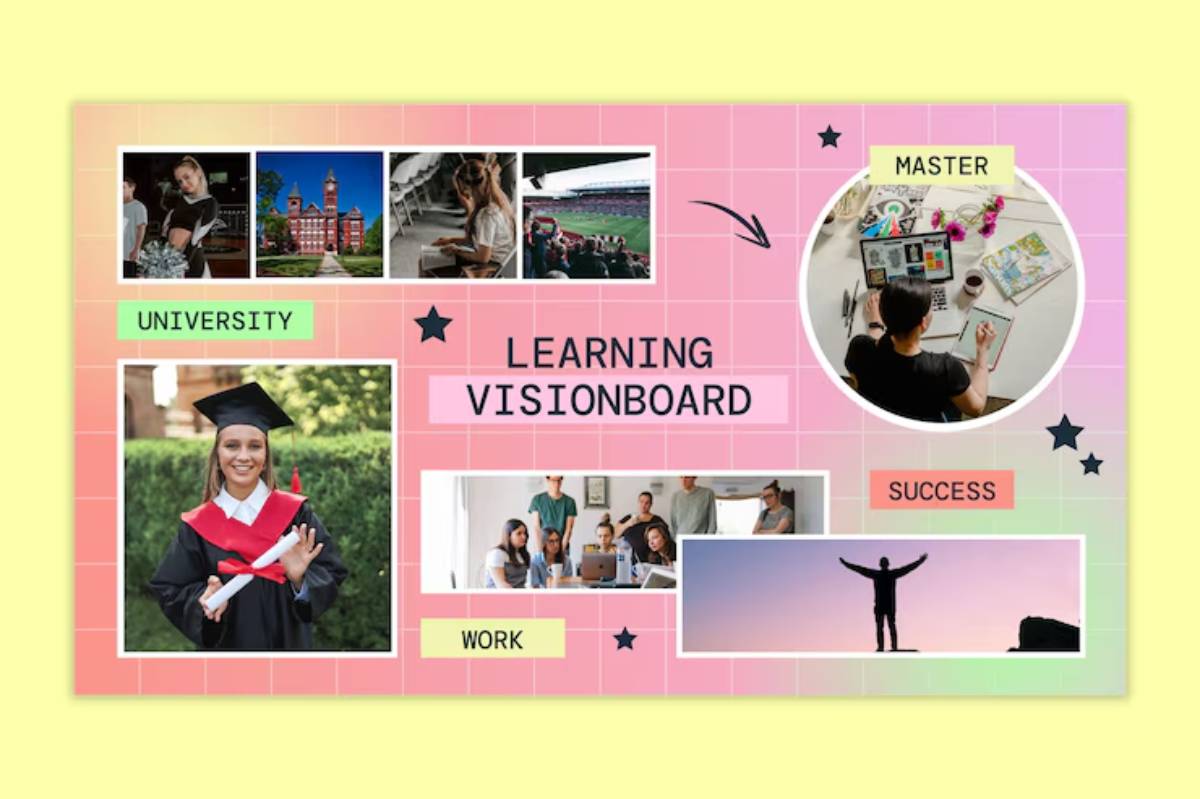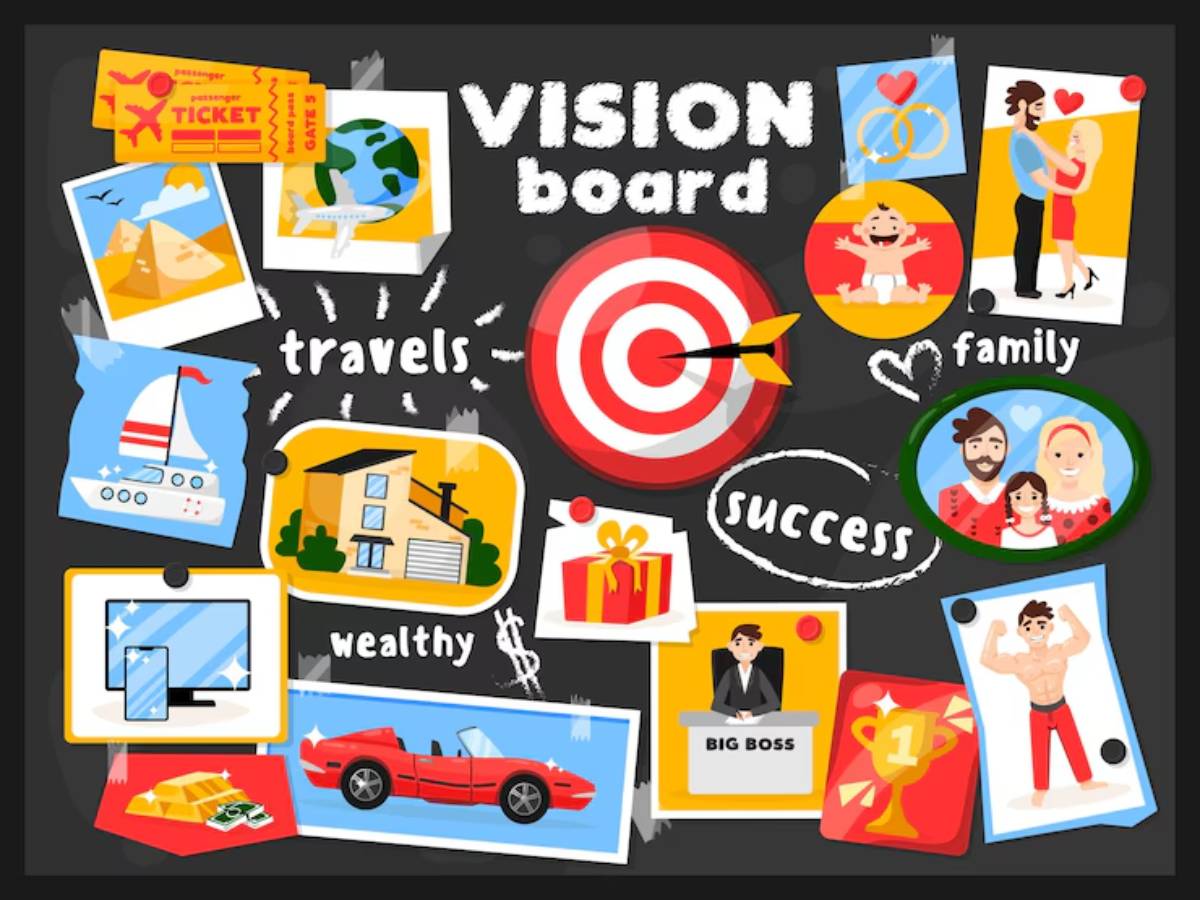
Vision Boards for Students and Young Adults
There’s a moment—usually somewhere between high school projects, college applications, or that first dive into job hunting—when the future suddenly feels very real. And a little overwhelming.
Sound familiar?
That’s where a student’s goals board comes in. A vision board, when tailored to where you are and where you want to be, can turn stress into strategy and vague daydreams into concrete intentions. Whether you’re a student balancing academics and side hustles or a young adult figuring out post-grad life, visual tools like vision boards offer clarity, motivation, and a surprisingly powerful form of accountability.
This guide breaks down how academic vision planning and youth future focus can go hand-in-hand with creativity. Let’s build something that doesn’t just look inspiring, but feels like the future you actually want.
Why Vision Boards Matter (Especially in Your Teens and 20s)
The pressure to “figure it all out” starts early. But most people don’t have all the answers by 22—or even 32. The truth is, vision boards aren’t about knowing exactly what you want. They’re about connecting with how you want to feel, grow, and live.
For students and young adults, a vision board:
- Helps clarify your goals (academic, personal, professional)
- Encourages regular self-reflection
- Builds confidence by visualising achievement
- Creates a safe space for dreaming bigger
And perhaps most importantly? It makes planning your future feel less like a chore—and more like a personal project you’re excited to revisit.
What to Include on a Student Goals Board
You don’t need to fill it with yachts and mansions (unless, hey, that’s your vibe). A meaningful vision board reflects your current journey and supports your evolving goals.
Here are some areas to consider, including:
1. Academic Goals
Think GPA, major, study habits, or grad school dreams. Represent it with:
- Photos of diplomas or graduation caps
- Quotes about perseverance or learning
- A checklist-style area for exams, assignments, or milestones
2. Career Aspirations
You don’t need a 10-year plan—just hints of what excites you:
- Logos from dream companies
- A mock business card with your future title
- Visuals of work environments you admire (remote office? creative studio?)
3. Personal Growth
Who do you want to become beyond academics?
- Books you want to read
- Journaling, therapy, or confidence quotes
- Icons representing self-trust, independence, or resilience
4. Social and Community Life
Friendship and connection matter.
- Photos of people laughing or supporting each other
- Volunteering or activism imagery
- Group activities you’d like to try—hiking, gaming, concerts
5. Lifestyle and Wellness
It’s not just about grades—it’s about quality of life.
- Travel goals or dream destinations
- Meal prep or sleep routines
- Photos that symbolise peace, fun, or balance
Choosing the Right Vision Board Format
Your board should match your style and attention span. Seriously.
Paper or Poster?
Great for tactile learners. Plus, you can hang it above your desk or bed.
Digital Boards (Pinterest or Canva)?
Perfect for tech-savvy students. You can update them quickly and keep them on your phone or laptop. Not sure how to start? Check out Using Pinterest & Canva for Vision Board Design for a full walkthrough.
Vision Journals or Notebooks?

Ideal if you want to combine words and visuals. You can treat each page as a goal section.
Quick Steps to Build Your Academic Vision Planning Board
Let’s make this easy.
Reflect Before You Begin
Ask:
- What am I proud of so far?
- What challenges do I want to overcome?
- What would a great year look like?
Don’t rush. This part grounds the rest.
Gather Visuals That Speak to You
These can come from:
- Magazines
- Free online printables
- Pinterest searches
- Your own photos or sketches
Choose what excites or motivates—not what you think should be on a vision board.
Layout by Theme
You can divide your board into quadrants (school, career, lifestyle, personal), or just arrange freely by mood. It doesn’t have to be linear. It just has to feel right to you.
Add Words That Anchor
Include:
- Affirmations: “I am capable of learning anything I commit to.”
- Quotes: From authors, mentors, even song lyrics
- Your own goals, deadlines, or reminders
Keep Your Youth Future Focus Alive
The board is done—now what?
Here’s how to keep it working for you:
1. Make It Visible

Hang it near your workspace. Set your digital board as a lock screen. Keep it in your planner.
2. Pair It With Action
Set mini goals that match what’s on the board. For example:
- If you added “Ace the SAT,” schedule weekly study blocks.
- If you pinned “Travel to Japan,” start a $5/week savings jar.
3. Reflect and Revisit Monthly
Take 10 minutes each month to look at your board. Ask:
- What still feels exciting?
- What needs tweaking?
- What progress am I making?
Common Mistakes to Avoid
Even the most beautiful board won’t mean much if it doesn’t reflect you.
Here are some pitfalls to steer clear of:
Mistake 1: Copying Someone Else’s Dream
Your board should reflect your hopes, not just what’s trending.
Mistake 2: Overcrowding
Leave space for things to evolve. You don’t need 100 images. Just the ones that resonate.
Mistake 3: Never Looking At It Again
The board only works if you engage with it. Make it a habit—not a one-time craft project.
Bonus: Vision Board Party for Students
Want to make the process more fun? Host a mini vision board event with friends.
You’ll need:
- Magazines or printers
- Scissors and glue
- Music and snacks
- A casual, judgment-free vibe
Vision board parties can boost motivation, spark fresh ideas, and create deeper connections. You’ll likely leave inspired by someone else’s vision too.
Real Talk: Your Goals Will Change—That’s Okay
The most powerful thing about vision boards? They’re flexible.
You might put “Get into Law School” on your board in January—and realise by June you’d rather start a nonprofit. That doesn’t make your original goal a failure. It means you’re growing.
Let your board be a living document. Add to it. Peel things off. Recreate it entirely if you need to. That’s not quitting—it’s adapting.
Want to make it even more engaging? Explore how creatives connect to the process in Creative Personality Vision Boards: Going Beyond the Norm.
Your Vision, Your Rules
There’s no single roadmap to adulthood. That’s the wild part—and the exciting part. Vision boards aren’t just about getting “there.” They’re about staying connected to your own voice while figuring it out.
So use a student goals board to honour the journey, not just the destination. Let your academic vision planning be rooted in what matters to you—not just what sounds impressive. And remember, when it comes to a youth future focus, dreaming is allowed to be weird, bold, colourful, and completely yours.
Start small. Pin what lights you up. Print what makes your heart race. Cut out what makes you laugh.
Then look at your board and say: “That? That’s where I’m headed.”
And even better? You’re already on your way.


